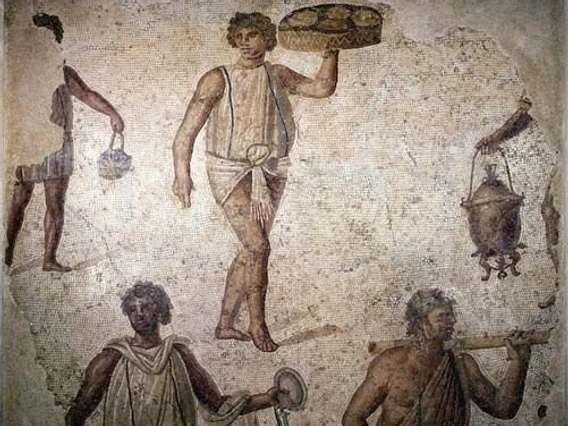
Ruins of the commercial agora in Ephesus, Turkey
Did you ever wonder where people in the ancient world bought the things that they needed for daily life? The answer is fairly simple–every Greek or Roman city had one or more commercial marketplaces where people would go to buy and sell goods.
The market (called the “agora” in Greek cities or the “forum” in Roman colonies like Pisidian Antioch) was a large, open-air plaza surrounded by a covered, column-lined walkway from which a series of doorways led into a range of small shops and offices. These spaces were used by local craftsmen and traders to meet with customers, produce their goods, and sell smaller items (and services like writing letters) to the general public.

Model showing the original appearance of the commercial agora in Ephesus, Turkey
In some of these markets, the type of business practiced in a particular shop was indicated by patterns in the tiled walkway in front of the shop, as in the photo below from Ostia in Italy.

The markets were managed by city-owned slaves under the oversight of the agoranomos, an elected official from the local elite class who was responsible for ensuring that the city had enough food for its needs and that business was conducted fairly and honestly. The people who held this office had no special training or expertise, and the officeholder could change whenever there was an election. It was therefore up to the slaves to keep things running smoothly and to maintain accurate records of the market’s operation.
On certain days (every eighth day in the Roman world), people from the surrounding farms brought their crops and handmade goods into the city for sale. Carts, tables, and small tents were erected in the center of the plaza as dictated by the slave managers. Sellers lined up early outside the city to get the best spots, since everyone (or their slaves, in the case of the wealthy citizens) packed the market on those days to replenish their kitchens and buy items that they could not produce at home.

Artist’s rendition of goods for sale in the center of the agora in a Greek city
Lucius, one of the two main characters in the A Slave’s Story trilogy, serves as agoranomos in the early chapters of A Rooster for Asklepios, and several other scenes take place in and around the markets. Hopefully this brief description and photos will help readers to better envision this element of the stories.



